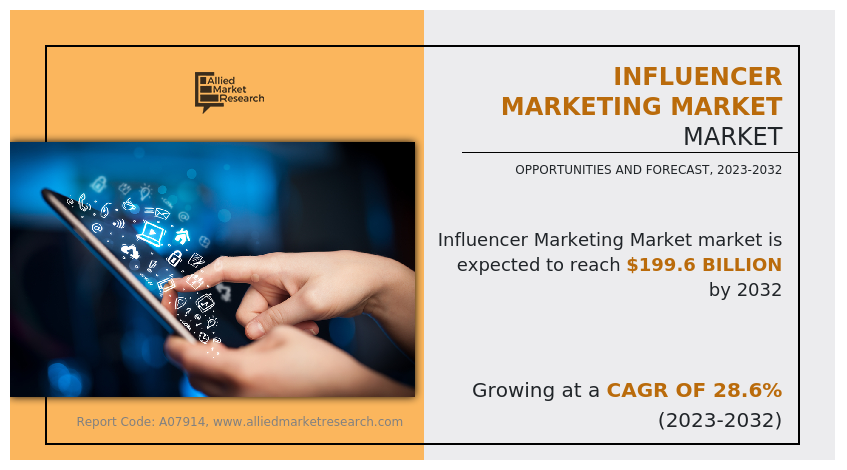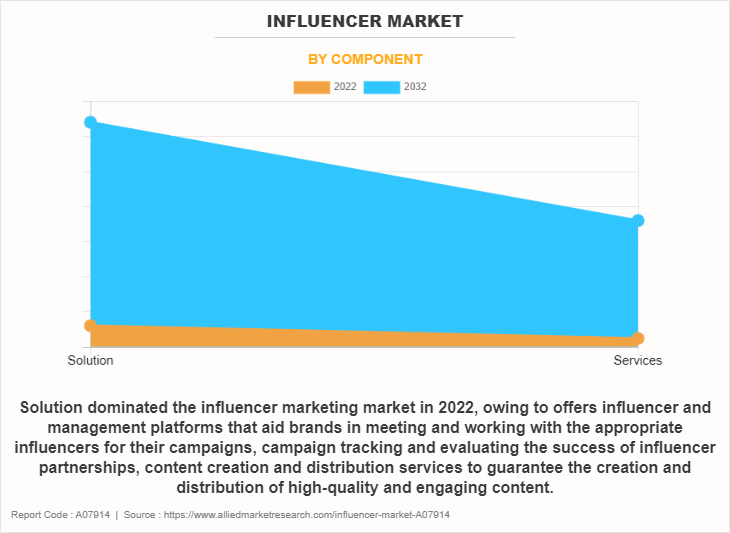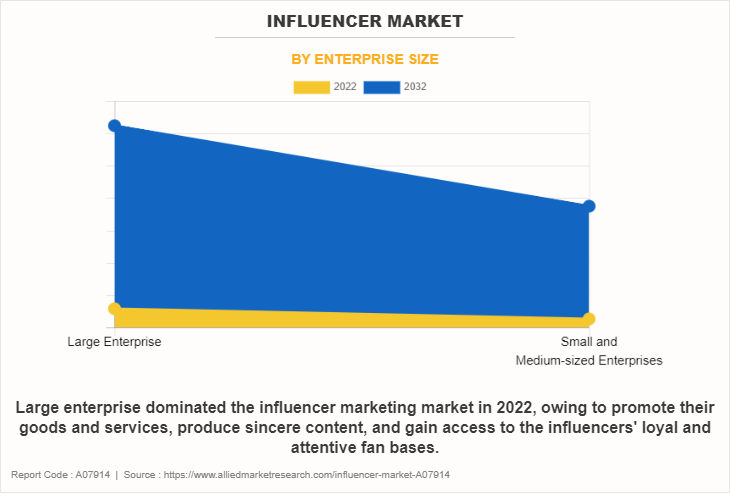Influencer Marketing Market Insights, 2032
The global influencer marketing market size was valued at $16.5 billion in 2022, and is projected to reach $199.6 billion by 2032, growing at a CAGR of 28.6% from 2023 to 2032.
Surge in legitimate engagement, digital transformation and cost-effective marketing are the major factors that is striking the market growth during the forecast period. However, regulatory and compliance barriers and concerns with authenticity and saturation is primarily restraining the market growth. Moreover, targeted niche markets is expected to create a lucrative opportunity for the influencer marketing market growth during the forecast period.

The influencer market refers to the sector and ecosystem that are oriented on the practice of brands seeking with influential people, sometimes referred to as influencers, to sell their goods or services to a target audience. Influencer marketing includes utilizing influencer’s followings, authority, and reach across a variety of social media paltform, including blogs, YouTube, Instagram, and TikTok. These influencers have a loyal fan base and the power to influence the audience's purchasing choices. Brands, agencies, influencers, and digital platforms that enable influencer partnerships are some of the many stakeholders in the business. It involves tasks including finding influencers, planning and executing campaigns, creating content, managing influencers, measuring results, and tracking performance. Thus, the influencer marketing market has seen substantial growth in recent years due to the growth of social media.
Moreover, influencer marketing is gaining significant value by brands as a crucial tool for reaching target audiences, enhancing brand recognition, rising engagement, and boosting revenue. As a result, there are many players offering a variety of services and solutions to satisfy the demands of brands and influencers within the influencer marketing ecosystem, which has led to a highly competitive market and influencer marketing industry.
The influencer market is segmented on the basis of component, enterprise size, application, vertical and region. On the basis of component, it is categorized into solution and services. On the basis of enterprise size, it is bifurcated into large enterprises and small and medium-sized enterprises (SMEs). On the basis of application, it is divided into campaign management, influencer relationship management, data analytics and reporting, compliance management, and others.
On the basis of vertical, it is fragmented into BFSI, fashion and lifestyle, healthcare and wellness, ad-tech, retail and e-commerce goods, travel and tourism, and others. On the basis of region, it is analyzed across North America, Europe, Asia-Pacific, and LAMEA.
The report focuses on growth prospects, restraints, and analysis of the global influencer marketing market trend. The study provides Porter’s five forces analysis to understand the impact of various factors, such as bargaining power of suppliers, competitive intensity of competitors, the threat of new entrants, threat of substitutes, and bargaining power of buyers on the global influencer marketing market share.

On the basis of component, solution segment dominated the influencer marketing market in 2022 and is expected to maintain its dominance in the upcoming years owing to offers finding influencer and management of platforms that aid brands in meeting and working with the appropriate influencers for their campaigns, campaign tracking and evaluating the success of influencer partnerships, content creation and distribution services to guarantee the creation and distribution of high-quality and engaging content propels the market growth significantly.
However, the service segment is expected to witness the highest growth during the influencer marketing market forecast, owing to organizations in finding the appropriate influencers, creating compelling campaigns, and achieving their marketing goals through successful influencer collaborations by utilizing their knowledge, industry connections, and technology.

On the basis of enterprise size, large enterprise segment dominated the influencer marketing market in 2022 and is expected to maintain its dominance in the upcoming years owing to promote their goods and services, produce sincere content, and gain access to the influencers' loyal and attentive fan bases. Influencer marketing presents opportunity for brands to interact more meaningfully and relatable with their target market, boosting brand loyalty and, eventually propels the influencer marketing market growth significantly.
However, the small and medium-size enterprise segment is expected to witness the highest growth, owing to enable small and medium-sized firms to work with influencers at various price ranges, avoiding traditional advertising channels in order to demand a substantial budget.
Competition Analysis:
Key influencer marketing company include NeoReach, Mavrck, Aspire, Traackr, Inc., HireInfluence Inc, SocialEdge, Inc., Hypetap, Upfluence, Klear, and IZEA Worldwide, Inc. Furthermore, it highlights the influencer marketingstrategies of the key players to improve the influencer marketing market share and sustain competition.
Top Impacting Factors:
Legitimate Engagement
A key factor propelling the influencer marketing industry is authentic engagement. Conventional advertising strategies frequently fail to engage today's cynical and tech-savvy consumers. Influencers provide a distinct viewpoint by being real and relatable. With their followers, they have already established credibility and trust, which makes their recommendations more sincere and powerful. When it comes to connecting with their target audience, marketers use this authenticity as a potent tool. Influencers produce material that appeals to their audience and skillfully integrate goods and services into their everyday routines.
Moreover, an audience perceives an influencer's sincere support of a brand as a personal endorsement. Higher engagement rates result from this degree of connection and trust, whether they come through shares, likes, or comments. Improved brand identification, expanded reach, and elevated conversion rates are the results of this interaction for brands. Furthermore, authenticity is also crucial for a brand's reputation. Collaborating with influencers who actually have faith in the brand's offerings guarantees that the brand's integrity and transparency are maintained. Influencer marketing is a major success factor in the modern marketing environment, where consumers seek authenticity.
Digital Transformation
Another significant driver propelling the influencer marketing industry is the digitalization of marketing and advertising. Traditional advertising techniques, including print and television, have lost some of their effectiveness as consumers spend more time online. Social media marketing, blogs, YouTube, and other digital spaces are where consumers interact, consume material, and make judgments about what to buy.
Influencer marketing takes advantage of this change by utilizing interactive features of digital platforms and vast online audiences. Brands understand that content creators on YouTube or Instagram have a greater opportunity of influencing customers than traditional advertising. These platforms offer influencers the ideal platform to authentically and naturally present things. Advanced targeting capabilities brought about by the digital transformation enable marketers to access certain audiences through influencers whose followers match the demographics of their target customers. As a result, highly targeted and successful marketing strategies that increase ROI and conversions are created.
Regional Insights:
The influencer marketing market is expanding globally, with brands leveraging social media influencers to engage with target audiences and enhance their marketing strategies. The influencer marketing platform market’s growth is driven by increasing social media usage, rising influencer credibility, and the demand for authentic content across regions.
North America leads the market, driven by the dominance of social media platforms like Instagram, YouTube, TikTok, and Twitter. The U.S. is a major player, with brands heavily investing in influencer marketing campaigns to target millennials and Gen Z audiences. Influencers across various industries, from beauty and fashion to fitness and technology, collaborate with brands to promote products through creative content. The region’s mature digital advertising ecosystem and consumer reliance on influencer recommendations are key factors driving growth. Additionally, companies are increasingly utilizing micro-influencers, who have smaller but highly engaged audiences, to boost authenticity and trust.
Europe is another significant region in the influencer marketing space, particularly in countries like the UK, Germany, and France. Influencers in Europe are often seen as trendsetters, particularly in fashion, beauty, and lifestyle sectors. The region’s influencer marketing campaigns are characterized by a focus on authenticity and creativity, aligning with European consumer preferences for relatable, trustworthy content. The growing popularity of sustainability and ethical products has also led to collaborations between influencers and eco-conscious brands, especially in sectors like sustainable fashion and organic beauty. European influencers are often recognized for their expertise, further driving engagement and conversion rates.
The Asia-Pacific region is witnessing rapid growth in the market, especially in countries like China, India, Japan, and South Korea. China leads with its massive social media user base on platforms like Weibo, Douyin (TikTok), and WeChat, where influencers, known as KOLs (Key Opinion Leaders), are highly influential in driving consumer behavior. In India, the rapid growth of Instagram and YouTube, along with a young, digitally savvy population, has fueled the rise of influencers in sectors like beauty, fitness, and technology. In South Korea, the K-pop wave and beauty industry dominate influencer marketing, with global reach and appeal.
In Latin America and the Middle East & Africa, influencer marketing is gaining traction, though on a smaller scale compared to other regions. In Latin America, influencers are primarily active in the beauty, lifestyle, and entertainment sectors, with countries like Brazil and Mexico leading the market. In the Middle East, influencers in fashion, luxury, and lifestyle are on the rise, driven by the region’s affluent consumer base and increasing social media penetration.
Recent Collaboration in the Market:
On June 2022, Mavrck, the leading influencer marketing platform for enterprise consumer brands, collaborated with TikTok and was named an Official TikTok Marketing Partner. Mavrck is directly integrated with the TikTok Creator Marketplace, empowering marketers to easily find and activate TikTok creators at scale, track their performance, and integrate them into their holistic influencer marketing program.
Recent Product Launch in the Market:
On September 2021, Traackr, the leading influencer marketing platform, launched the addition of new social commerce capabilities that empower brand marketers to better attribute sales from influencer partnerships and measure the impact of influencer programs on revenue. Traackr’s social commerce capabilities deliver an end-to-end workflow to increase traffic from social media paltform to a brand’s e-commerce site, drive sales, streamline commission payments to influencers, and provide transparent metrics to measure their impact.
Recent Partnership in the Market:
On August 2021, IZEA Worldwide, Inc. partnered with leading data and technology provider PlaceIQ, to bring real-world attribution to influencer marketing campaigns. PlaceIQ, the technology company using location data insights to craft a new model of consumer behavior and IZEA, the premier provider of influencer marketing technology, data, and services for leading brands, are working together to bridge the online/offline gap in media attribution.
On January 2022, CreatorIQ, the customer intelligence cloud that serves clients like HandM, Disney, and CVS, partnered with TikTok marketing partner. This gave brands that use the platform access to creator and content metrics from the TikTok Creator Marketplace within the CreatorIQ dashboard. This will provide insights not only into demographics and trends but also help select the best creators to work with. '
Key Benefits for Stakeholders:
- This report provides a quantitative analysis of the influencer marketing market size, segments, current trends, estimations, and dynamics of the influencer marketing market analysis from 2022 to 2032 to identify the prevailing influencer marketing market opportunities.
- The influencer marketing market research is offered along with information related to key drivers, restraints, and opportunities.
- Porter's five forces analysis highlights the potency of buyers and suppliers to enable stakeholders make profit-oriented business decisions and strengthen their supplier-buyer network.
- In-depth analysis of the influencer marketing market segmentation assists to determine the prevailing market opportunities.
- Major countries in each region are mapped according to their revenue contribution to the global market.
- Market player positioning facilitates benchmarking and provides a clear understanding of the present position of the market players.
- The report includes the analysis of the regional as well as global influencer marketing market trends, key players, market segments, application areas, and influencer marketing market growth strategies.
Influencer Marketing Market Report Highlights
| Aspects | Details |
| Market Size By 2032 | USD 199.6 billion |
| Growth Rate | CAGR of 28.6% |
| Forecast period | 2022 - 2032 |
| Report Pages | 386 |
| By Component |
|
| By Enterprise size |
|
| By Application |
|
| By Vertical |
|
| By Region |
|
| Key Market Players | Aspire, HireInfluence inc, Mavrck, Upfluence, IZEA Worldwide, Inc., Hypetap, SocialEdge, Inc., NeoReach, Klear, Traackr, Inc |
Analyst Review
The influencer marketing industry has experienced rapid expansion and change in recent years. Influencer marketing has developed into a potent tool for brands to engage with their target audience and generate commercial benefits as a result of the emergence of social media and the growing influence of online personalities. Influencer marketing entails working with powerful people, or influencers, who have a devoted following and the power to affect their audience's purchasing decisions. By utilizing the credibility and trust that influencers have gained from their followers, this type of marketing enables firms to take advantage of their reach and influence to market their goods or services. Moreover, the wide variety of stakeholders, including companies, agencies, influencers, and technology platforms, define the market. Influencer marketing is becoming a valuable tool for brands to raise brand awareness, encourage interaction, and eventually increase sales. Furthermore, different brands are investing a lot of money in influencer partnerships, budgeting for influencer marketing initiatives, and exploring long-term cooperation with influencers.
Additionally, the influencer marketing industry is very competitive and dynamic. Brands and agencies continuously seek fresh approaches to differentiate themselves and develop memorable campaigns. In order to engage their audience and stay relevant, influencers are constantly changing the way they create content. Technology platforms are emerging that offer tools for searching influencers, campaign management, and performance tracking to simplify the influencer marketing process. However, there are few restraints in the growth of influencer marketing. With issues like false followers and influencer fraud coming to light, there is growing concern about transparency and authenticity. To secure real partnerships and uphold the confidence of their audience, brands and platforms are putting more stringent restrictions and screening procedures in place.
Legitimate Engagement and digital transformation are the upcoming trends of Influencer Marketing Market in the world.
Targeted Niche Markets is the leading application of Influencer Marketing Market
North America is the largest regional market for Influencer Marketing.
The Influencer marketing Market was valued for $16531.18 million in 2022 and is estimated to reach $199600.38 million by 2032, exhibiting a CAGR of 28.6% from 2023 to 2032.
NeoReach, Mavrck, Aspire, Traackr, Inc., HireInfluence Inc, SocialEdge, Inc., Hypetap, Upfluence, Klear, and IZEA Worldwide, Inc. are the top companies to hold the market share in Influencer Marketing.
Loading Table Of Content...
Loading Research Methodology...


